Assessing and Optimizing Ecological Flow Rates for the Habitat of Zacco platypus in the Tan River
Abstract
:1. Introduction
2. Materials and Methods
2.1. Study Area
2.2. The Concept of the PHABSIM Model
2.3. Constructing the PHABSIM Input Data
2.3.1. Construction of Hydraulic and Hydrological Data Using the HEC-RAS
2.3.2. Fish HSI
3. Results and Discussion
3.1. Results of the Tan River Flow Analysis
3.2. Determination of Optimal Ecological Flow
3.2.1. Results of the Ecological Flow Determination for the Last 10 Years
3.2.2. Seasonal Ecological Flow Calculation Results
3.3. Range of Ecological Flow
3.3.1. Calculation of Ecological Flow Range for the Last 10 Years
3.3.2. Seasonal Ecological Flow Range Estimation Results
3.3.3. Analysis of Days Meeting Ecological Flow Requirements in the Tan River
4. Conclusions
Supplementary Materials
Author Contributions
Funding
Data Availability Statement
Conflicts of Interest
References
- Kim, K.O.; Park, Y.K.; Kang, J.I.; Lee, B.S. Estimation of ecological flow and habitat suitability index at Jeonju-cheon upstream. J. Korean Soc. Environ. Eng. 2016, 38, 47–55. (In Korean) [Google Scholar] [CrossRef]
- Kim, T.G.; Yoon, Y.N.; Ahn, H.H. An analysis on the changes of flow duration characteristics due to dam construction. J. Korea Water Resour. Assoc. 2002, 35, 807–816. (In Korean) [Google Scholar] [CrossRef]
- Kang, S.K.; Yoo, C.S.; Lee, D.Y.; Choi, S.J. Improvement of instream flow evaluation methodology and application. J. Korean Soc. Hazard Mitig. 2016, 16, 295–304. (In Korean) [Google Scholar] [CrossRef]
- Ministry of Land, Infrastructure, and Transport. Guidelines for Determining River Maintenance Flow; Ministry of Land, Infrastructure, and Transport: Tokyo, Japan, 2009. (In Korean)
- Hotzel, G.; Croome, R. A Phytoplankton Methods Manual for Australian Freshwaters; LWRRDC Occasional Paer 22/99; Land and Water Research and Development Corporation: Canverra, Australia, 1999; pp. 1–58. [Google Scholar]
- Domingues, R.B.; Galvao, H. Phytoplankton and environmental variability in a dam regulated temperate estuary. Hydrobiologia 2007, 586, 117–134. [Google Scholar] [CrossRef]
- Cabecinha, E.; Cortes, R.; Cabral, J.A.; Ferreira, T.; Lourenco, M.; Pardal, M.A. Multi-scale approach using phytoplankton as a first step towards the definition of the ecological status of reservoirs. Ecol. Indic. 2009, 9, 240–255. [Google Scholar] [CrossRef]
- Jung, C.G.; Lee, J.W.; Ahn, S.R.; Hwang, S.J.; Kim, S.J. Assessment of ecological streamflow for maintaining good ecological water environment. J. Korean Soc. Agric. Eng. 2016, 58, 1–12. [Google Scholar]
- Kang, H.S.; Hur, J.W. Aquatic ecosystem assessment and habitat improvement alternative in Hongcheon River using fish community. J. Korean Soc. Civ. Eng. 2012, 32, 331–343. (In Korean) [Google Scholar]
- Kang, J.H.; Lee, E.T.; Lee, J.H.; Lee, D.H. Estimation of river instream flow considering fish habitat conditions. J. Korea Water Resour. Assoc. 2004, 37, 915–927. (In Korean) [Google Scholar] [CrossRef]
- Kim, K.H. Evaluation of Habitat Conditions and Estimation of Optimum Flow for the Freshwater Fish. Doctor’s Thesis, Yonsei University, Seoul, Republic of Korea, 1999; pp. 77–80. (In Korean). [Google Scholar]
- Sung, Y.D.; Park, B.J.; Joo, G.J.; Jung, K.S. The estimation of ecological flow recommendations for fish habitat. J. Korea Water Resour. Assoc. 2005, 38, 545–554. (In Korean) [Google Scholar] [CrossRef]
- Heon, L.J.; Man, J.S.; Ho, L.M.; Su, L.Y. Estimation of Instream Flow for Fish Habitat using Instream Flow Incremental Methodology(IFIM) for Major Tributaries in Han River Basin. J. Korean Soc. Civ. Eng. B 2006, 26, 153–160. (In Korean) [Google Scholar]
- Kang, H.; Im, D.; Hur, J.W.; Kim, K.H. Estimation of habitat suitability index of fish species in the Geum River watershed. KSCE J. Civ. Environ. Eng. Res. 2011, 31, 193–203. (In Korean) [Google Scholar]
- Jang, K.H.; Park, Y.K.; Kang, J.I.; Kim, M.H. Estimation of ecological flow rate for Zacco platypus based on habitat suitability index considering probability density function. J. Korea Water Resour. Assoc. 2018, 51, 207–219. (In Korean) [Google Scholar]
- Gard, M. Comparison of spawning habitat predictions of PHABSIM and River2D models. Int. J. River Basin Manag. 2009, 7, 55–71. [Google Scholar] [CrossRef]
- Seo, I.W.; Park, I.H. Determination of ecological flow at the confluence of Nakdong River and Gumho River using River2D. J. Korean Soc. Civ. Eng. 2013, 33, 947–956. [Google Scholar]
- Hur, J.W.; Kim, D.H.; Kang, H.S. Estimation of optimal ecological flowrate of fish in Chogang Stream. J. Korean Soc. Ecol. Infrastruct. Eng. 2014, 1, 39–48. [Google Scholar]
- Kang, H.S.; Choi, B.W. Dominant fish and macroinvertebrate response to flow changes of the Geum River in Korea. Water 2018, 10, 942. (In Korean) [Google Scholar] [CrossRef]
- Park, J.; Jang, S.; Song, I. Estimation of an optimum ecological stream flow in the Banbyeon Stream using PHABSIM-focused on Zacco platypus and Squalidus chankaensis tsuchigae. J. Korean Soc. Agric. Eng. 2020, 62, 51–62. (In Korean) [Google Scholar]
- Bowen, Z.H.; Freeman, M.C.; Bovee, K.D. Evaluation of generalized habitat criteria for assessing impacts of altered flow regimes on warmwater fishes. Trans. Am. Fish. Soc. 1998, 127, 455–468. [Google Scholar] [CrossRef]
- Valentin, S.; Lauters, F.; Sabaton, C.; Breil, P.; Souchon, Y. Modelling temporal variations of physical habitat for brown trout (Salmo trutta) in hydropeaking conditions. Regul. Rivers Res. Manag. 1996, 12, 317–330. [Google Scholar] [CrossRef]
- Yi, Y.; Wang, Z.; Yang, Z. Impact of the gezhouba and three gorges dams on habitat suitability of carps in the Yangtze river. J. Hydrol. 2010, 387, 283–291. [Google Scholar] [CrossRef]
- Kim, S.K.; Choi, S.U. Change of fish habitat in a downstream reach of a stream due to dam construction. Ecol. Resilient Infrastruct. 2014, 1, 61–67. [Google Scholar] [CrossRef]
- Seoul State. Tan River and 10 Other River Basic Plans; Seoul Metropolitan No. 2015–386: Seoul, Republic of Korea, 2015. [Google Scholar]
- Stalnaker, C.B. The Instream Flow Incremental Methodology: A Primer for IFIM; US Department of the Interior, National Biological Service: Gainesville, FL, USA, 1995; Volume 29.
- Roh, K.B. Study on Habitat Conservation Fish and Management Using Ecological Model in Seomjin River. Doctor’s Thesis, Graduate School Dong-shin University, Naju, Republic of Korea, 2011. (In Korean). [Google Scholar]
- Lee, J.J.; Hur, J.W. Comparative Analysis of Environmental Ecological Flow Based on Habitat Suitability Index (HSI) in Miho stream of Geum river system. Ecol. Resilient Infrastruct. 2022, 9, 68–76. (In Korean) [Google Scholar]
- Jung, S.; Ji, U.; Kim, K.H.; Jang, E.K. Analysis of weighted usable area and estimation of optimum environmental flow based on growth stages of target species for improving fish habitat in regulated and non-regulated rivers. J. Korea Water Resour. Assoc. 2019, 52, 811–822. (In Korean) [Google Scholar]
- Choi, J.K.; Jang, C.R.; Byeon, H.K. The characteristic of fish fauna by habitat type and population of Zacco platypus in the Tan Stream. Korean J. Environ. Ecol. 2011, 25, 71–80. (In Korean) [Google Scholar]
- US EPA. Fish Field and Laboratory Methods for Evaluating the Biological Integrity of Surface Waters; EPA 600-R-92-111; Environmental Monitoring Systems Laboratory-Cincinnati Office of Modeling, Monitoring systems, and Quality Assurance Office of Research Development, U.S. EPA: Cincinnati, OH, USA, 1993.
- Barbour, M.T.; Gerritsen, J.; Snyder, B.D.; Stribling, J.B. Rapid Bilassessment Protocols for Use in Streams and Wadeable Rivers: Periphyton, Benthic Macroinvertebrates and Fish, 2nd ed.; EPA 841-B-99-002; U.S. Environmental Protection Agency, Office of Water: Washington, DC, USA, 1999.
- Yoon, S.J.; Choi, J.K.; Lee, H.G. Comparison of fish distribution characteristics by substrate structure in the 4 streams1a. Korean J. Environ. Ecol. 2014, 28, 302–313. (In Korean) [Google Scholar] [CrossRef]
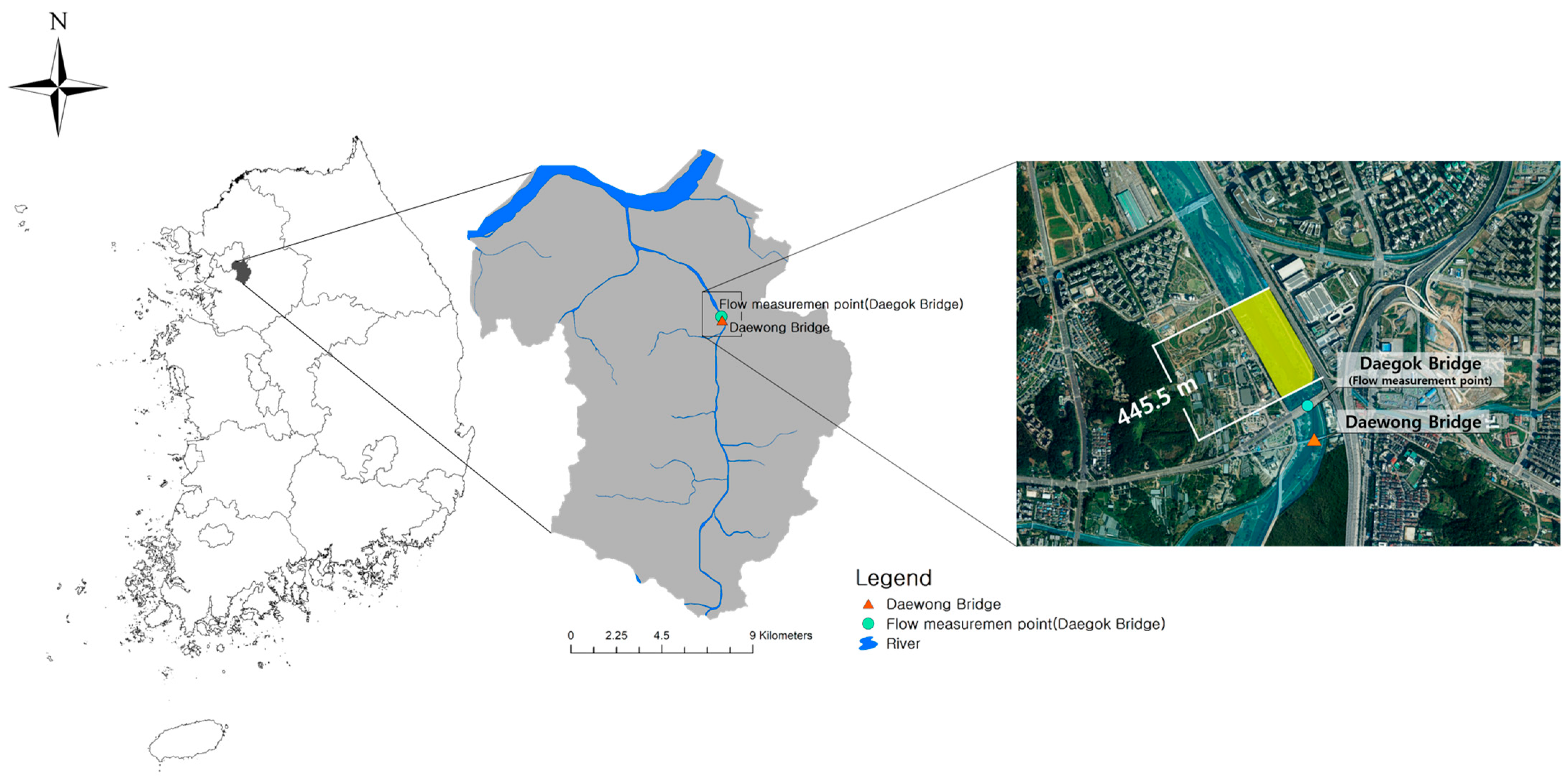
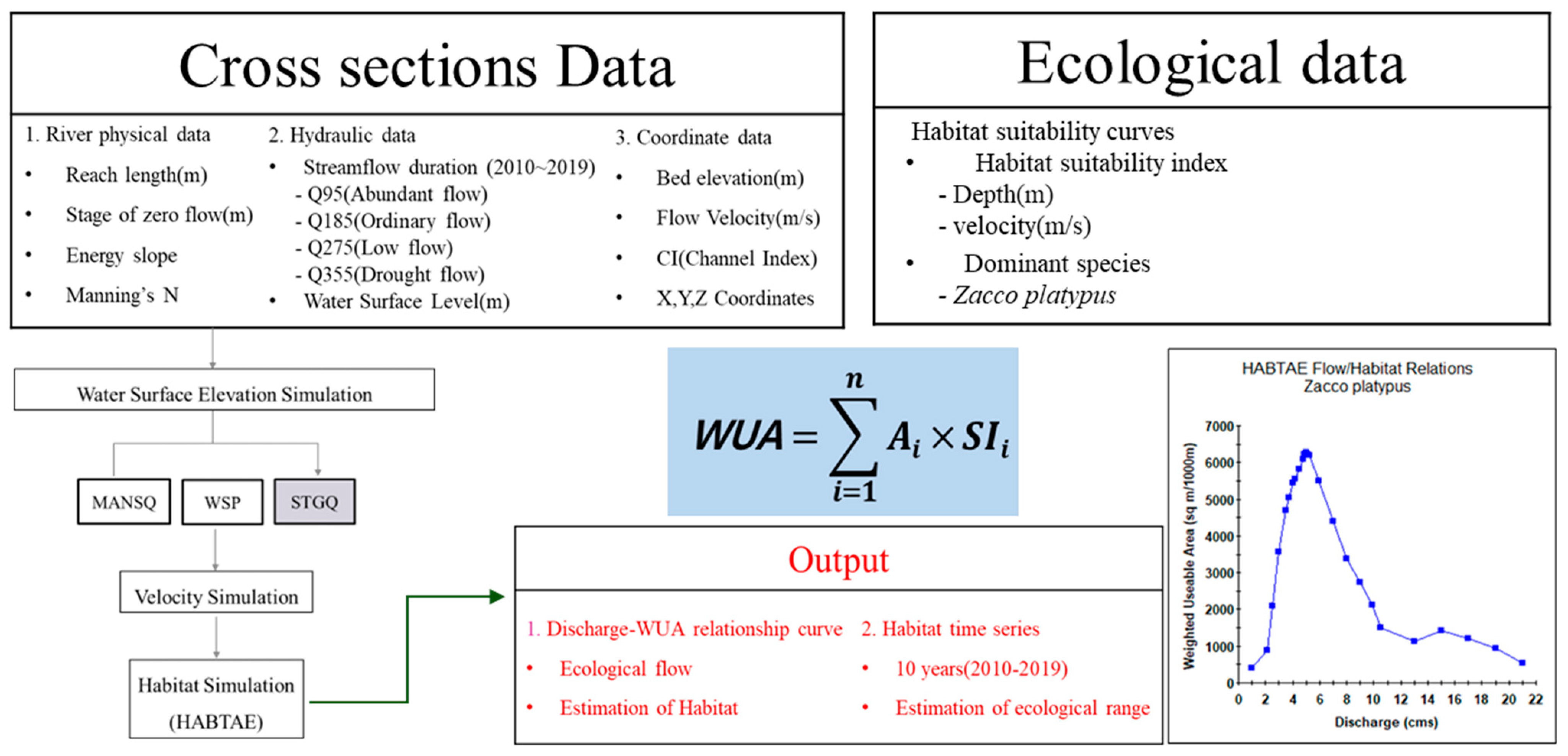
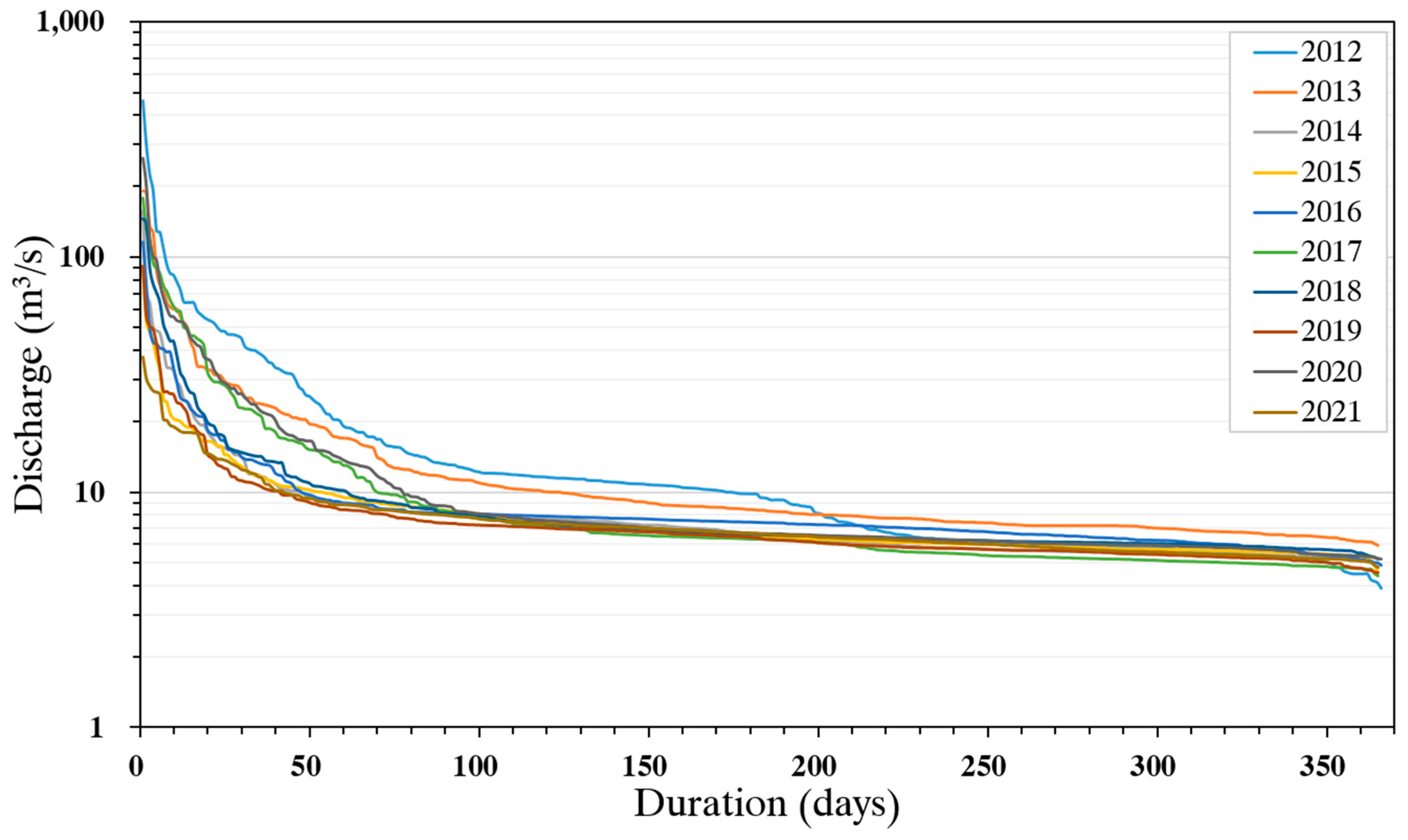
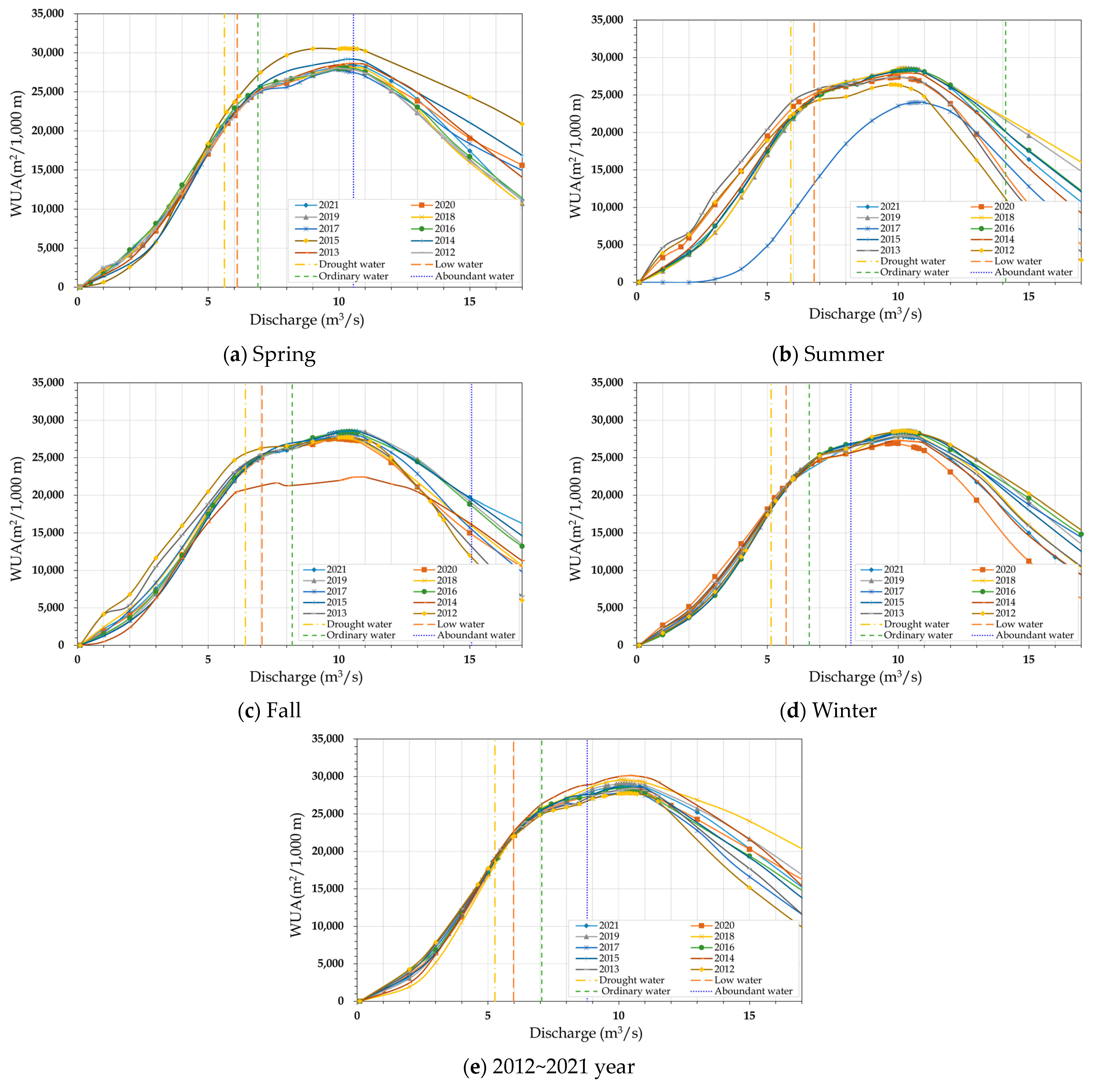
| Index | Number of Measurements | Rating | ||||
|---|---|---|---|---|---|---|
| A | B | C | D | E | ||
| Trophic Diatom Index (TDI) | 20 | 0 | 1 | 3 | 5 | 11 (55%) |
| Benthic Macroinvertebrate Index (BMI) | 20 | 0 | 0 | 2 | 5 | 13 (65%) |
| Fish Assessment Index (FAI) | 20 | 0 | 0 | 2 | 6 | 12 (60%) |
| Habitat and Riparin Index (HRI) | 11 | 0 | 0 | 2 | 8 (73%) | 1 |
| Riparian Vegetation Index (RVI) | 7 | 0 | 0 | 4 (57%) | 3 | 0 |
| Target Fishes | Zacco platypus |
|---|---|
| Appearance | 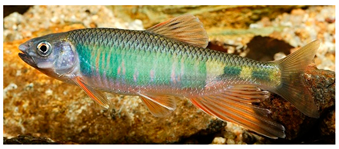 |
| HSI | 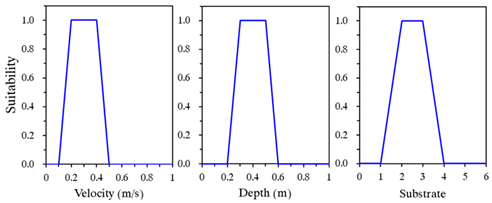 |
| Unit: m3/s | ||||||||||||||||||||
|---|---|---|---|---|---|---|---|---|---|---|---|---|---|---|---|---|---|---|---|---|
| Year | WUA PERCENT (%) | |||||||||||||||||||
| 100 | 95 | 90 | 85 | 80 | 75 | 70 | 65 | 60 | 55 | 50 | 45 | 40 | 35 | 30 | 25 | 20 | 15 | 10 | 5 | |
| 2012 | 10.4 | 8.09 | 7.15 | 6.58 | 6.13 | 5.75 | 5.40 | 5.08 | 4.77 | 4.48 | 4.19 | 3.91 | 3.62 | 3.33 | 3.04 | 2.73 | 2.41 | 2.05 | 1.64 | 1.13 |
| 2013 | 10.5 | 8.34 | 7.27 | 6.68 | 6.22 | 5.84 | 5.49 | 5.17 | 4.87 | 4.58 | 4.29 | 4.01 | 3.73 | 3.45 | 3.16 | 2.86 | 2.53 | 2.18 | 1.77 | 1.26 |
| 2014 | 10.4 | 8.31 | 7.36 | 6.81 | 6.38 | 6.01 | 5.68 | 5.38 | 5.09 | 4.82 | 4.55 | 4.28 | 4.02 | 3.75 | 3.48 | 3.20 | 2.91 | 2.59 | 2.23 | 1.79 |
| 2015 | 10.4 | 7.95 | 7.13 | 6.63 | 6.23 | 5.89 | 5.58 | 5.29 | 5.01 | 4.74 | 4.48 | 4.21 | 3.94 | 3.67 | 3.38 | 3.08 | 2.75 | 2.38 | 1.94 | 1.33 |
| 2016 | 10.1 | 7.91 | 7.04 | 6.55 | 6.17 | 5.84 | 5.54 | 5.26 | 4.99 | 4.72 | 4.46 | 4.19 | 3.92 | 3.63 | 3.33 | 2.99 | 2.61 | 2.15 | 1.53 | 0.73 |
| 2017 | 10.2 | 7.79 | 6.95 | 6.46 | 6.07 | 5.73 | 5.42 | 5.14 | 4.86 | 4.59 | 4.33 | 4.06 | 3.79 | 3.51 | 3.22 | 2.90 | 2.55 | 2.15 | 1.66 | 0.99 |
| 2018 | 10.1 | 8.31 | 7.31 | 6.79 | 6.39 | 6.05 | 5.74 | 5.46 | 5.20 | 4.94 | 4.69 | 4.44 | 4.19 | 3.93 | 3.67 | 3.39 | 3.10 | 2.78 | 2.40 | 1.92 |
| 2019 | 10.2 | 8.09 | 7.21 | 6.69 | 6.27 | 5.92 | 5.59 | 5.30 | 5.01 | 4.74 | 4.47 | 4.21 | 3.94 | 3.67 | 3.40 | 3.11 | 2.80 | 2.46 | 2.06 | 1.56 |
| 2020 | 10.2 | 8.01 | 7.12 | 6.62 | 6.23 | 5.90 | 5.60 | 5.31 | 5.04 | 4.78 | 4.51 | 4.25 | 3.98 | 3.70 | 3.41 | 3.09 | 2.73 | 2.32 | 1.78 | 0.99 |
| 2021 | 10.3 | 8.16 | 7.17 | 6.64 | 6.24 | 5.89 | 5.57 | 5.28 | 4.99 | 4.72 | 4.45 | 4.19 | 3.92 | 3.64 | 3.35 | 3.04 | 2.70 | 2.32 | 1.85 | 1.21 |
| Avg. | 10.3 | 8.10 | 7.17 | 6.64 | 6.23 | 5.88 | 5.56 | 5.27 | 4.98 | 4.71 | 4.44 | 4.17 | 3.91 | 3.63 | 3.34 | 3.04 | 2.71 | 2.34 | 1.89 | 1.29 |
| SD | 0.13 | 0.18 | 0.12 | 0.10 | 0.09 | 0.10 | 0.10 | 0.11 | 0.12 | 0.12 | 0.13 | 0.14 | 0.15 | 0.16 | 0.17 | 0.18 | 0.19 | 0.21 | 0.26 | 0.35 |
| Season | Year | Number of Days Satisfied | Total Number of Days |
|---|---|---|---|
| Appropriate Environmental Ecological Flow Rate Range | |||
| Spring | 2012 | 29 (32%) | 92 |
| 2013 | 51 (55%) | 92 | |
| 2014 | 14 (15%) | 92 | |
| 2015 | 18 (20%) | 92 | |
| 2016 | 89 (97%) | 92 | |
| 2017 | 8 (9%) | 92 | |
| 2018 | 58 (63%) | 92 | |
| 2019 | 7 (8%) | 92 | |
| 2020 | 52 (57%) | 92 | |
| 2021 | 50 (54%) | 92 | |
| Summer | 2012 | 61 (66%) | 92 |
| 2013 | 91 (99%) | 92 | |
| 2014 | 46 (50%) | 92 | |
| 2015 | 26 (28%) | 92 | |
| 2016 | 34 (37%) | 92 | |
| 2017 | 59 (64%) | 92 | |
| 2018 | 28 (30%) | 92 | |
| 2019 | 29 (32%) | 92 | |
| 2020 | 88 (96%) | 92 | |
| 2021 | 43 (47%) | 92 | |
| Fall | 2012 | 91 (100%) | 91 |
| 2013 | 91 (100%) | 91 | |
| 2014 | 91 (100%) | 91 | |
| 2015 | 90 (99%) | 91 | |
| 2016 | 70 (77%) | 91 | |
| 2017 | 91 (100%) | 91 | |
| 2018 | 89 (98%) | 91 | |
| 2019 | 91 (100%) | 91 | |
| 2020 | 91 (100%) | 91 | |
| 2021 | 45 (49%) | 91 | |
| Winter | 2012 | 44 (48%) | 91 |
| 2013 | 90 (100%) | 90 | |
| 2014 | 44 (49%) | 90 | |
| 2015 | 49 (54%) | 90 | |
| 2016 | 72 (79%) | 91 | |
| 2017 | 36 (40%) | 90 | |
| 2018 | 85 (94%) | 90 | |
| 2019 | 40 (44%) | 90 | |
| 2020 | 90 (100%) | 90 | |
| 2021 | 51 (57%) | 90 | |
| Sum | Spring Sum | 376 (41%) | 920 |
| Summer Sum | 505 (55%) | 920 | |
| Fall Sum | 840 (92%) | 910 | |
| Winter Sum | 601 (67%) | 902 | |
| 10-Year Total | 2322 (64%) | 3652 |
Disclaimer/Publisher’s Note: The statements, opinions and data contained in all publications are solely those of the individual author(s) and contributor(s) and not of MDPI and/or the editor(s). MDPI and/or the editor(s) disclaim responsibility for any injury to people or property resulting from any ideas, methods, instructions or products referred to in the content. |
© 2024 by the authors. Licensee MDPI, Basel, Switzerland. This article is an open access article distributed under the terms and conditions of the Creative Commons Attribution (CC BY) license (https://creativecommons.org/licenses/by/4.0/).
Share and Cite
Noh, Y.; Kim, S.; Hong, E. Assessing and Optimizing Ecological Flow Rates for the Habitat of Zacco platypus in the Tan River. Water 2024, 16, 2583. https://doi.org/10.3390/w16182583
Noh Y, Kim S, Hong E. Assessing and Optimizing Ecological Flow Rates for the Habitat of Zacco platypus in the Tan River. Water. 2024; 16(18):2583. https://doi.org/10.3390/w16182583
Chicago/Turabian StyleNoh, Yeonjung, Seongjoon Kim, and Eunmi Hong. 2024. "Assessing and Optimizing Ecological Flow Rates for the Habitat of Zacco platypus in the Tan River" Water 16, no. 18: 2583. https://doi.org/10.3390/w16182583






